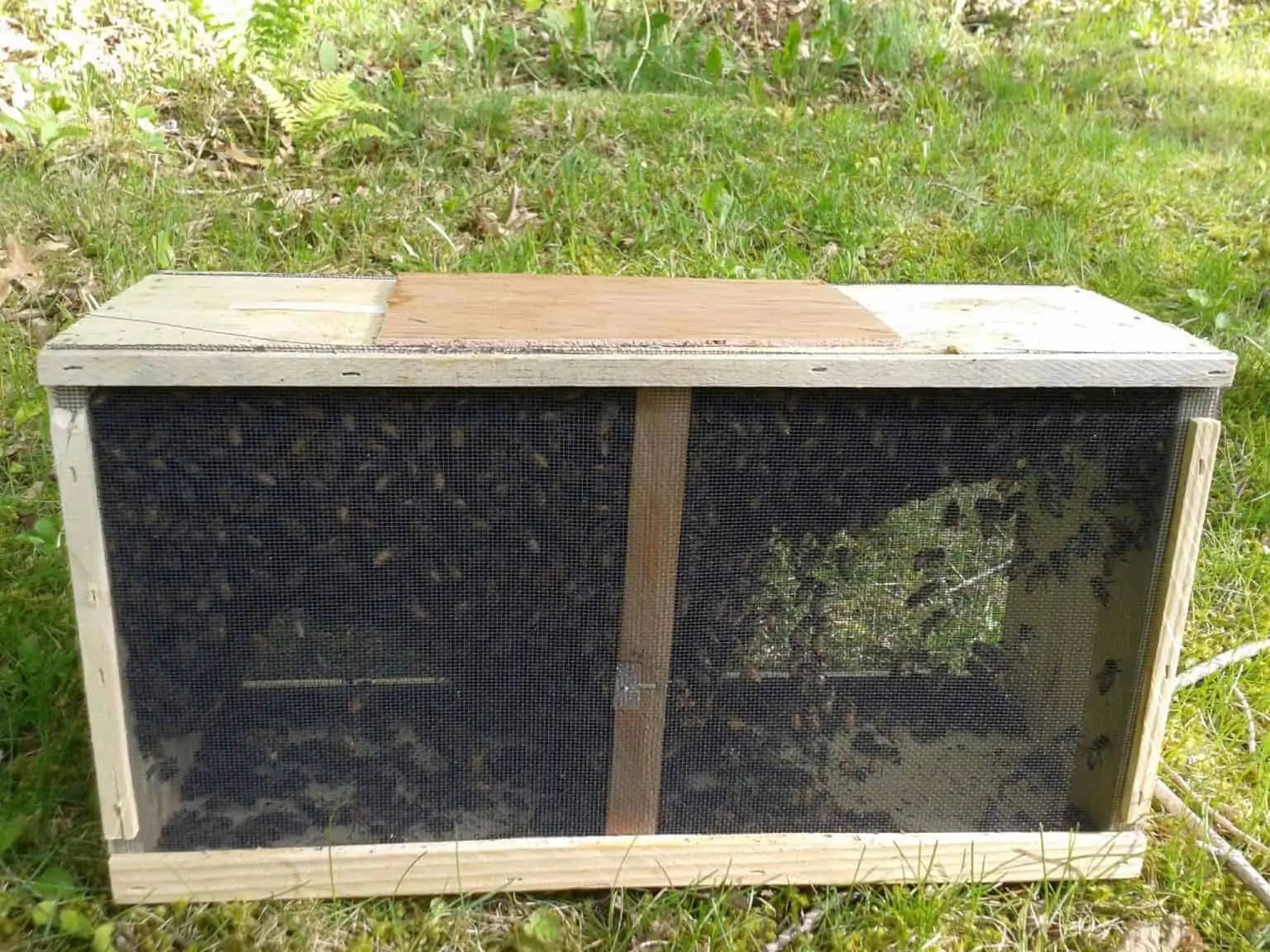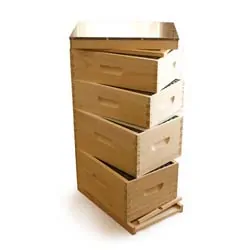Hive Bought. Hive In Place. Next up… bees!
Thus far, we’ve looked at choosing a hive and selecting an appropriate location for the hive. With their future home ready to go, it’s now time to determine where the bee occupants will come from, and if purchasing a package, what breed(s) may be best. As with selecting a hive type, many of the factors in choosing bees will revolve around your personal choices for hive management. There are two distinctly different ways that most beekeepers obtain their bees.
Purchasing a Package of Bees
A package of bees can be purchased and shipped to the beekeeper’s selected location (yes, bees come through the USPS just like a letter. They do the same thing with baby chickens) or a swarm can be caught/trapped. Packaged bees are not a “family.” The queen is bred separately and must initially be separated from the rest of the hive to give them time to accept her and not attempt to kill her. Packages have 2 screened sides held together by wooden frames and contain a large metal feeder can full of sugar water. The queen is separated by a queen cage, which hangs down from the top of the package. As a newbie, I decided to go with purchasing a package of bees, but quickly learned there a many factors to consider.
Sarah Woodard
First, since I was looking to keep my hive chemical free and as close to nature’s way as possible, I needed to locate bees who were born and reared in hives that were also chemical free and were “small cell.” Small cells bees are bees who are not forced to build their comb on foundations intended to push the bees into building larger than normal cells. Some breeders and keepers opt for “large cell” bees believing that bigger bees will somehow be stronger. I figured bees are sized the way they’re supposed to be and thus went in search of small cell bees that had never been exposed to chemicals.
The next consideration was breed. This can be an extremely complicated topic and I’m not a biologist, but I knew I wanted bees who were docile since the hive is situated in my back yard and also bees who were hardy enough to withstand the rough New Hampshire winters. Armed with that and very little knowledge about the specifics of bee breeds, I opted for “mutt” bees. The hybrid in particular I chose, based on some advice during my bee class, consisted of Russian, Carnelian, and Italian. Prevailing thoughts were that this particular mix was docile, hardy, and reasonably decent honey producer.
The third consideration was exactly where to purchase bees. Using the two facts just discussed, and also logically thinking bees from a New England source would make them that much more likely to be able to over-winter, I set about searching for the appropriate vendor. And that, I think, is where I made my first newbie mistake. I found a vendor in Maine selling chemical-free, small cell bees. Sounded great to me, so I made the purchase and patiently waited for the bees to arrive. I found out later, much later, that these bees actually began their life in a bee yard in Tennessee. Not exactly the hardy New England bees I was looking for… and this turned out to be a bigger problem than I’d ever imagined, but that’s for another post on another day.
Trapping a Swarm
After several false starts with packaged bees, I started to think it might be better to get super-local bees by catching a swarm. This, however, is a scary and difficult prospect. Also, with natural bee populations in severe decline, the possibility of locating a swarm is quite small. And even if I did find one, I’d have to catch it in a box and relocate it to my hive. Frequently, such efforts involve standing on ladders while holding a large cardboard box and cutting a branch (or branches) off a tree with such precision that the branch and bees land in the box. Not exactly my thing… I don’t like ladders and my hand-eye coordination leaves a lot to be desired.
A more passive solution to catching a swarm involved baiting the hive. Bees rely on their sense of smell, in conjunction with sight, to determine the best location for a new hive. The smell of brood and queen pheromone sends the signal that a particular location is habitable. So, to bait a hive, I’d have to provide both of these smells. Queen pheromone smells like lemongrass essential oil, so that part’s pretty easy. A few drops on a cotton ball does the trick. Brood comb is tougher. The only way to obtain that is to get it from a hive, but with Foul Brood and other hive illnesses on the rise, I’d have to be sure to get brood comb from a clean, uninfected (certified as such), and chemical free, hive. Not an easy task.
So far, I’ve not attempted trapping a swarm by either method. The fact is, I’ve seen so few bees in my area, I’m not sure there are any I could catch anyway. At this point, I’m researching other places to get a package. Somewhere much closer to home than TN so they’ll have better shot at surviving the winter.
Thus far, we’ve looked at choosing a hive and selecting an appropriate location for the hive. With their future home ready to go, it’s now time to determine where the bee occupants will come from, and if purchasing a package, what breed(s) may be best. As with selecting a hive type, many of the factors in choosing bees will revolve around your personal choices for hive management. There are two distinctly different ways that most beekeepers obtain their bees.
Purchasing a Package of Bees
A package of bees can be purchased and shipped to the beekeeper’s selected location (yes, bees come through the USPS just like a letter. They do the same thing with baby chickens) or a swarm can be caught/trapped. Packaged bees are not a “family.” The queen is bred separately and must initially be separated from the rest of the hive to give them time to accept her and not attempt to kill her. Packages have 2 screened sides held together by wooden frames and contain a large metal feeder can full of sugar water. The queen is separated by a queen cage, which hangs down from the top of the package. As a newbie, I decided to go with purchasing a package of bees, but quickly learned there a many factors to consider.
First, since I was looking to keep my hive chemical free and as close to nature’s way as possible, I needed to locate bees who were born and reared in hives that were also chemical free and were “small cell.” Small cells bees are bees who are not forced to build their comb on foundations intended to push the bees into building larger than normal cells. Some breeders and keepers opt for “large cell” bees believing that bigger bees will somehow be stronger. I figured bees are sized the way they’re supposed to be and thus went in search of small cell bees that had never been exposed to chemicals.
The next consideration was breed. This can be an extremely complicated topic and I’m not a biologist, but I knew I wanted bees who were docile since the hive is situated in my back yard and also bees who were hardy enough to withstand the rough New Hampshire winters. Armed with that and very little knowledge about the specifics of bee breeds, I opted for “mutt” bees. The hybrid in particular I chose, based on some advice during my bee class, consisted of Russian, Carnelian, and Italian. Prevailing thoughts were that this particular mix was docile, hardy, and reasonably decent honey producer.
The third consideration was exactly where to purchase bees. Using the two facts just discussed, and also logically thinking bees from a New England source would make them that much more likely to be able to over-winter, I set about searching for the appropriate vendor. And that, I think, is where I made my first newbie mistake. I found a vendor in Maine selling chemical-free, small cell bees. Sounded great to me, so I made the purchase and patiently waited for the bees to arrive. I found out later, much later, that these bees actually began their life in a bee yard in Tennessee. Not exactly the hardy New England bees I was looking for… and this turned out to be a bigger problem than I’d ever imagined, but that’s for another post on another day.
Trapping a Swarm
After several false starts with packaged bees, I started to think it might be better to get super-local bees by catching a swarm. This, however, is a scary and difficult prospect. Also, with natural bee populations in severe decline, the possibility of locating a swarm is quite small. And even if I did find one, I’d have to catch it in a box and relocate it to my hive. Frequently, such efforts involve standing on ladders while holding a large cardboard box and cutting a branch (or branches) off a tree with such precision that the branch and bees land in the box. Not exactly my thing… I don’t like ladders and my hand-eye coordination leaves a lot to be desired.
A more passive solution to catching a swarm involved baiting the hive. Bees rely on their sense of smell, in conjunction with sight, to determine the best location for a new hive. The smell of brood and queen pheromone sends the signal that a particular location is habitable. So, to bait a hive, I’d have to provide both of these smells. Queen pheromone smells like lemongrass essential oil, so that part’s pretty easy. A few drops on a cotton ball does the trick. Brood comb is tougher. The only way to obtain that is to get it from a hive, but with Foul Brood and other hive illnesses on the rise, I’d have to be sure to get brood comb from a clean, uninfected (certified as such), and chemical free, hive. Not an easy task.
So far, I’ve not attempted trapping a swarm by either method. The fact is, I’ve seen so few bees in my area, I’m not sure there are any I could catch anyway. At this point, I’m researching other places to get a package. Somewhere much closer to home than TN so they’ll have better shot at surviving the winter.


